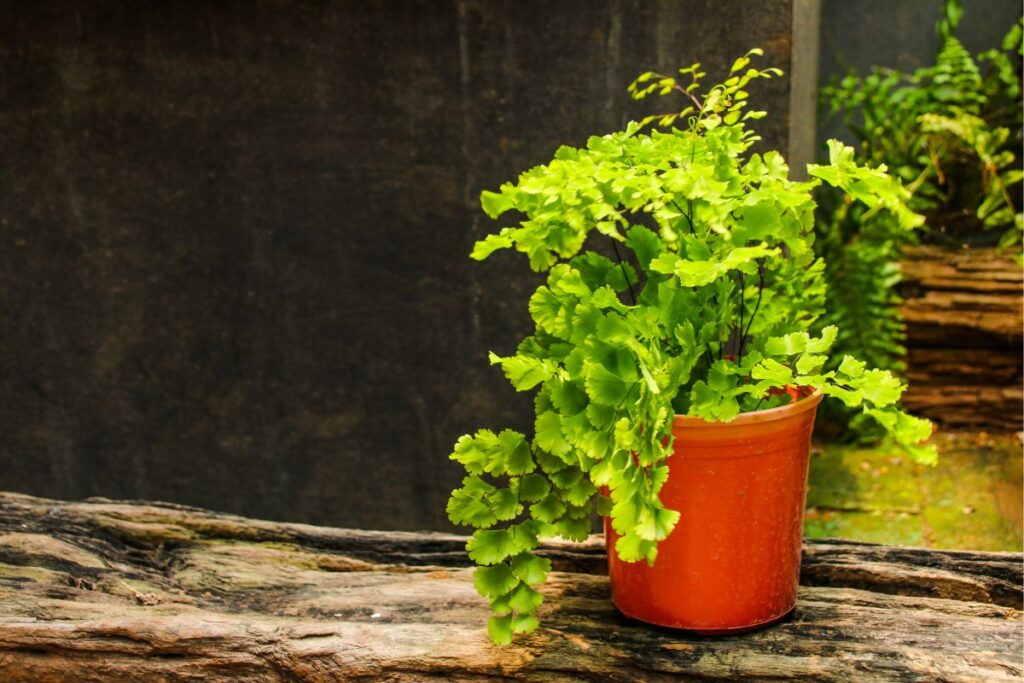The Maidenhair Fern, or Adiantum, is a delicate and elegant houseplant known for its lacy, fan-shaped fronds and graceful appearance. This beautiful fern adds a touch of natural charm to any indoor space. It’s an excellent choice for both seasoned plant enthusiasts and beginners due to its relatively easy care requirements. In this guide, we’ll cover everything you need to know to keep your Maidenhair Fern thriving.

Contents
Why Choose Maidenhair Fern?
Maidenhair Fern offers several benefits:
- Aesthetic Appeal: Its lacy, fan-shaped fronds add a touch of elegance to any room.
- Air Purification: It helps remove toxins from the air, contributing to a healthier indoor environment.
- Easy Care: It requires minimal maintenance, making it perfect for busy lifestyles.
Ideal Growing Conditions
Light
Maidenhair Fern thrives in bright, indirect light. It can tolerate lower light conditions but will grow more slowly. Avoid direct sunlight, which can scorch the delicate fronds.
Water
Maidenhair Fern prefers consistently moist soil but not waterlogged. Water when the top inch of soil is dry, which is typically every 1-2 weeks. Use room-temperature water and avoid letting the soil dry out completely. Mist the leaves regularly to maintain humidity.
Soil
Use a well-draining soil mix. A standard potting mix with added perlite or peat works well. Ensure the pot has drainage holes to prevent water from pooling at the bottom.
Temperature and Humidity
Maidenhair Fern prefers temperatures between 60-75°F (15-24°C). It thrives in high humidity. If your home has dry air, especially in winter, consider using a humidifier or placing the fern on a pebble tray with water.
Fertilizing
Feed your Maidenhair Fern during the growing season (spring and summer) with a balanced liquid fertilizer diluted to half strength. Fertilize once a month to provide essential nutrients for healthy growth.
Potting and Repotting
Maidenhair Fern can stay in the same pot for several years. However, when the plant outgrows its pot or you notice roots coming out of the drainage holes, it’s time to repot:
- Choose a pot that is 1-2 inches larger in diameter than the current one.
- Fill the new pot with a well-draining soil mix.
- Gently remove the plant from its old pot and shake off excess soil.
- Place the plant in the new pot and fill around it with soil.
- Water lightly and place it in a suitable location.
Propagation
Maidenhair Fern can be propagated through division:
- Remove the plant from its pot.
- Gently separate the root clump into smaller sections, ensuring each section has roots and fronds.
- Plant each section in its own pot with fresh soil.
- Water lightly and place in a location with bright, indirect light until new growth appears.
Common Problems and Solutions
Yellow Leaves
Yellow leaves can be a sign of overwatering or insufficient light. Allow the soil to dry out slightly between waterings and ensure the plant receives enough indirect light.
Brown Tips
Brown tips on the fronds can be caused by dry air, inconsistent watering, or exposure to direct sunlight. Increase humidity by misting the leaves or using a humidifier and avoid direct sunlight.
Pests
Maidenhair Fern can be susceptible to pests like spider mites and aphids. Regularly inspect the plant and treat any infestations with insecticidal soap or neem oil.
Styling Tips
Maidenhair Fern is a versatile plant that can be styled in various ways:
- Living Room: Place in a bright corner to showcase its delicate fronds.
- Bathroom: The high humidity in bathrooms makes them an ideal location for Maidenhair Ferns.
- Office: Add a touch of elegance to your workspace with a beautiful fern.
- Grouping: Combine with other houseplants to create a lush, indoor garden effect.
Conclusion
The Maidenhair Fern is a resilient and attractive addition to any indoor garden. With minimal care, it will reward you with its delicate, lacy fronds and air-purifying benefits. Whether you’re a seasoned plant parent or a beginner, the Maidenhair Fern is sure to thrive and bring a touch of elegance and natural beauty into your home.
